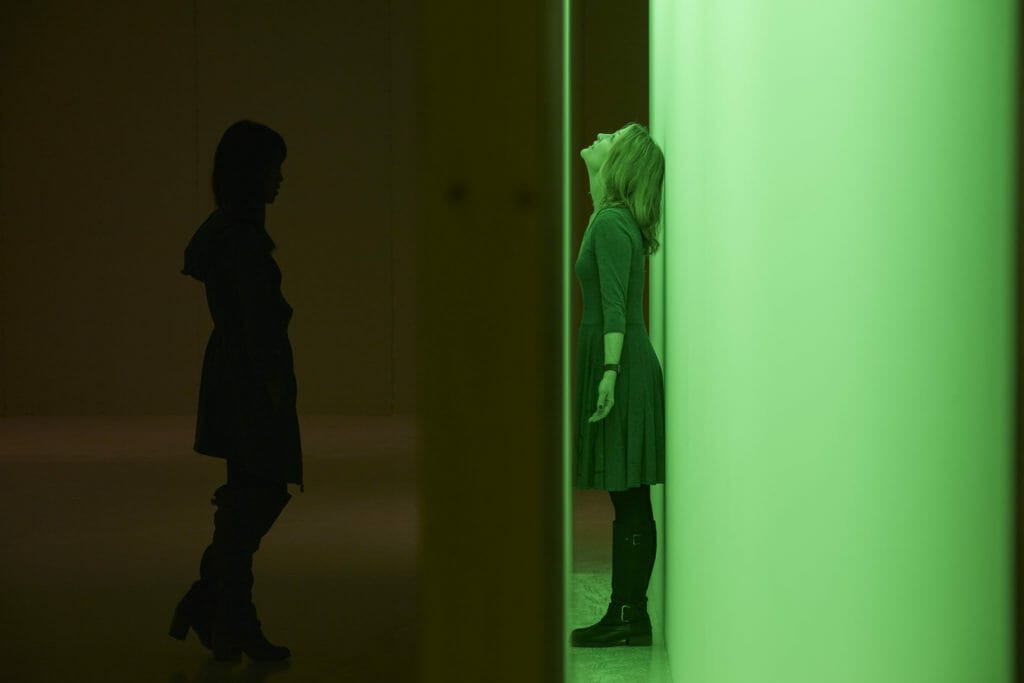Can a non-dancer imagine what it feels like to perform an intricate dance?
Imagine moving through space totally conscious of where every part of your body is and how it appears to others…
Walker Art Museum has taken on this task— and succeeded!
Walker Art Center Exhibit is Larger Version of Chicago MCA One
The exhibit mixes media much like the sister MCA exhibit of the same name. It is a retrospective of famed choreographer Merce Cunningham, who is pictured in the photo below.
The exhibit sprawls through six bright, white galleries at the Walker Art Center in the heart of downtown Minneapolis. This writer was immediately drawn in by the various costumes, videos, and music that tell the story of Cunningham’s life and work.
In the first gallery, a set of costumes and some stage props from past performances of the dance company greet us. We are drawn in by several colorful pieces.
Off to the side of the gallery is a room devoted to John Cage, composer and music director to the company. He was also Merce’s life partner and composed many pieces for Cunningham’s performances. In the room, there are tributes to his life, biographies, and his compositions playing in the background. His musical style embraced chance and he often threw die to make musical choices.
Throughout the exhibit Merce’s influential performances are seen on projected screens and accompanied by sets and costumes. There are also pieces of importance from people he collaborated with and who were involved with the company. In addition to the room dedicated to John Cage, there is also one devoted to David Tudor, who also played a particularly important part in the music compositions of the Cunningham dance company. We see dozens of black and white photographs of Merce himself and members of the company. Sketches of dancers and choreographed dances hang around the galleries. We see work from Andy Warhol, who had designed many of the sets used by the company.
The Music
The music accompanying the visual pieces’ echoes throughout the galleries . One can hear three or more compositions at different points ,which often results in some disorientation. It is very different from what one would typically expect of accompanying music. Cage’s music focuses on rhythmic structure over harmonic structure, resulting in several intriguing and mysterious pieces.
The Visual
Cunningham’s interest in technologies as a source of inspiration in his dance in one of the most unique things about this exhibit. One can see how important the sets were to the company and how the innovation went beyond just the dances.
A particularly memorable room has overlapping visual projections of dances on several screens at different angles. You can see many dances and recordings of Merce on the screens all at the same time. These videos were done by Charles Atlas. Your own shadow projects onto the screens making you a part of the experience.
The exhibit invites you to explore all of this for yourself. A favorite from the MCA exhibit also appears in the Walker. A room with silver clouds blowing around allows you to interact with the set in a similar as the original dancers would have. This was from a set originally designed by Andy Warhol. Another interesting part has the viewer walk through a narrow, green lit hallway. There is also a hallway that gradually gets narrower. Both make the viewer aware of their own body and space on a stage. One of the key elements in Merce’s choreography.
Mixed Medias
At times, the exhibit can be disorienting and overwhelming. This writer came to feel over stimulated in a few of the rooms where there is much to experience and take in. However, this is the style of Merce Cunningham, his many collaborators and his innovative dance company.. It is well worth a visit to see the sets, costumes, and dances on film. You will learn about Merce Cunningham, a choreographer who changed the direction of modern dance in his time.
When:
Exhibit open from February 8–July 30, 2017
Mon: Closed
Tue, Wed, Sun: 11 am – 5 pm
Thu: 11 am – 9 pm
Fri, Sat: 11 am – 6 pm
Where:
Walker Art Center
725 Vineland Place
Minneapolis, MN 55403
Tickets:
Adults: $14
Members: Free
Seniors (62+): $12
Active Military: $7
Students: $9
Youth (<18): Free
For more information--
Read the Picture this Post review of the Museum of Contemporary Art “Merce Cunningham: Common Time” exhibit here.
And also follow ongoing and expanding coverage of this exhibit through Chicago’s choreographers’ eyes-- “Meet Merce: Choreographer Spotlights” and comments about Merce Cunningham by various choreographers in "Choreographers' Eyes- Dancers Explain Dance."
Photos: Rachel Joyce, (c) Walker Art Center.

